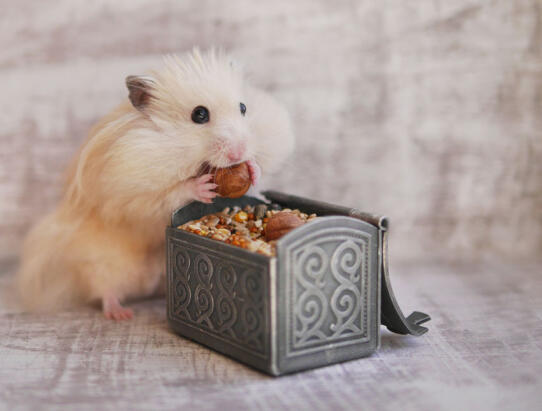All hamsters are small rodents, the largest is the European hamster. They have short legs and short tails, features that are normal for an animal that spends much of it's time underground. Their legs are extremely strong so that burrowing in the ground is easy for them. They can also walk up to 8 miles in a single night of foraging for food.
The tail, ears and feet are covered in a fine fur and the rest of the body is covered in a much thicker fur. This helps keep the hamster warm in the cold winter nights.
Probably the most famous characteristic of hamsters is of course their ability to stuff loads of food into their cheeks. They have special cheeks which can expand out to their shoulders and it means they can forage a long way from their burrow but still transport the food back. Hamsters think its very funny that we have to use shopping bags, they think cheeks are much more convenient.

Perhaps the most famous feature of these animals is their ability to cram a lot of food into their cheeks
The five senses
Eyesight
All hamsters are mostly active at dawn and dusk so they have large eyes but this does not mean they have good eyesight. In fact it's not very good at all. They do not seem to have any perception of depth - a hamster coming to the end of a solid surface will simple drop off the edge because it doesn't know how far the fall is. They are brilliant climbers and will quickly climb up to the top of curtains and get down by simply letting go.If a hamster detects movement from above it will go onto it's back so that it can defend itself using it's feet and teeth. In the wild this would be a bird but in the home this could mean your hands reaching down to pick it up. That's why you should always approach your hamster from in front.
Smell
What a hamster lacks in eyesight it makes up for with it's sense of smell. As soon as you open the fridge door, that little nose will start twitching and the nostrils will be flaring. Your hamster will search out favourite foods such as sunflower seeds from food dishes even when put under all the other foods. Fresh greens, and best of all a dandelion leaf have even been known to wake a sleeping hamster who can't resist a nibble.Hearing
Hamsters have very good hearing. You should notice that when awake, your hamsters ears are upright to catch as much sound as possible. In relaxed or sleepy mode the ears are folded or crumpled. It is surprising how quickly young hamsters learn to associate certain clinking sounds of dishes etc with being fed. Your hamster will learn the sound of your voice and so you should regularly talk to it, just don't expect much more than the occasional squeak back.Taste
Hamsters are omnivores which means they eat vegetables as well as meat. In the wild they would mostly eat seeds and grasses but they are quite happy when they find an insect to eat.Touch
Hamster have extremely dexterous front paws. If you watch your hamster feeding or cleaning itself you'll see just how finely it can move it's fingers.Whiskers
With nocturnal animals whiskers play an important role while traveling to forage for food in the dark. Just remember that hamsters dislike having their extremely sensitive whiskers touched so be careful not to pull them or stroke them.

Comments
Phil, 26 April 2023
Great article. I loved how humor was used in the descriptions. My hamsters definitely know the yummy stuff is coming when I start preparing their meals
Skyla, 19 December 2011
this taught me more about hamsters. I love my robovoski Raisin!